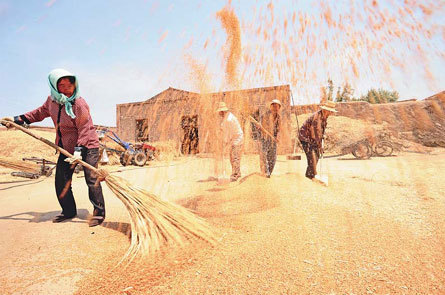It's being called the world's worst food crisis since the 1970s. Around the globe, food prices have risen about 40% in the last year, sparking protests and violence in at least 14 countries, and pushing the problem to center stage at the United Nations. The rapidly escalating crisis of food availability around the world has reached emergency proportions. Economists blame the runaway prices on an imbalance between the world's supply of food and a recent rise in demand. Demand has been growing rapidly as a result of rapid income growth in many developing countries, especially as you know, in China, in India, and elsewhere in Asia.
这是20世纪70年代以来全球范围内最严重的粮食危机了。全球范围内,仅去年,粮食价格就上涨了近40%,这引发了至少14个国家的抗议和暴力事件,促使该问题成为联合国的中心议题。全球范围内可用粮食的危机迅速升温已经达到了紧急的程度。经济学家认为,物价飙升是因为粮食供应无法满足最近激增的需求。很多发展中国家,比如中国、印度等亚洲国家,其收入快速增长,这导致需求迅速增长。
Even as the world is eating more, some farmers in the west have turned to growing corn or sugar cane or something other than food to produce fuel. This year, as much as a quarter of the US corn crop will go to ethanol plants reducing the land available to grow food. Grain has also become increasingly valuable on the global market, partly because droughts around the world, especially in Australia, have led to poor harvests.

Other grain-producing countries, such as Argentina and Ukraine have cut back grain exports in a bid to control inflation at home. The result in spikes and cost of food has sparked violent protests in the Caribbean, Africa and Asia. In recent months, Egypt was rocked by two days of riots over high food prices and low wages. Demonstrators took to the streets in Peru, and crowds looted in Somalia. In Haiti, violent protests claimed several lives and cost Haitian Prime Minister Jacques-Edouard Alexis his job. In Vietnam panic shoppers flocked to markets to stock up on rice which rose 100% over a 48-hour period.
Local consumers saw people lining up to buy rice in other countries on TV, so they got in a panic. But Vietnam produces rice. It is impossible for our country to have a rice shortage problem. Hardest-hit by the food crisis are the world's poor. People in developing countries spend up to 70% of their income on food. So rising prices can quickly lead to hunger. But even in wealthy countries, consumers are feeling pinched.
In the US, many shoppers are clipping coupons and cutting back on luxury items. US food prices in 2008 are forecast to rise about double the increases of recent years. Experts expect world food prices to rise even further. But even when supply and demand find a new equilibrium, few expect prices to drop much, if any, suggesting that more expensive food is here to stay.












